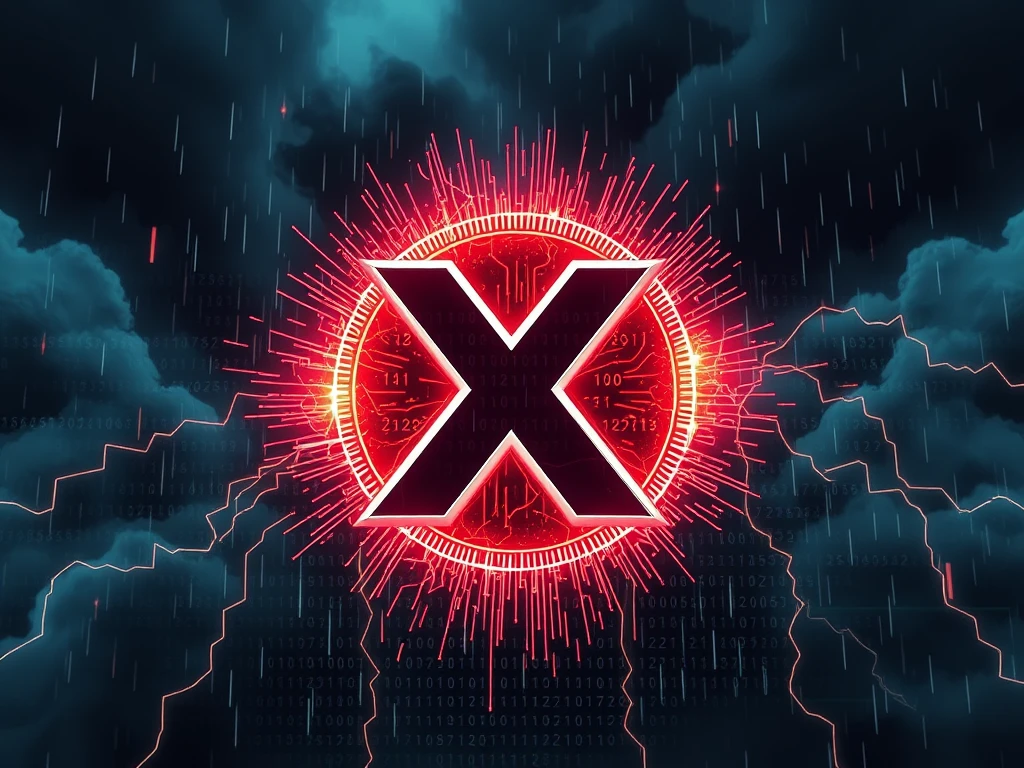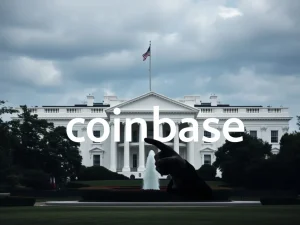Decoding the X Outage: The Shocking Truth Behind Elon Musk’s Cyberattack

On a seemingly ordinary day, the digital world held its breath as X, formerly known as Twitter, experienced a significant outage. Users worldwide found themselves locked out, timelines frozen, and a wave of confusion washing over the platform. The mastermind behind X, Elon Musk, was quick to point fingers at a “massive cyberattack.” But what really happened? Was it truly a sophisticated nation-state assault, or was there more to the story behind this disruptive X outage? Let’s unravel the layers of this digital drama and understand why it’s a wake-up call for everyone in the interconnected world.
Unveiling the Cause: The Anatomy of the X Outage
March 10, 2025, is a date etched in the memory of many X users. Services faltered, timelines went blank, and the familiar blue bird logo seemed to mock our digital dependence. Initial reports flooded in – over 21,000 in the US and 10,800 in the UK alone, painting a picture of widespread disruption. As the chaos unfolded, Elon Musk took to X, his own platform, to declare a “massive cyberattack.”
The initial narrative leaned towards a state-sponsored or highly organized group, with fingers pointed at Ukrainian IP addresses. However, cybersecurity experts quickly cautioned against jumping to conclusions based solely on IP addresses. In the murky world of cybercrime, masking locations through compromised devices is a common tactic.
So, ditching the initial speculation, what was the actual culprit behind the X outage? The answer is less about espionage and more about brute force: a large-scale Distributed Denial of Service (DDoS) attack. Imagine a digital traffic jam of epic proportions – that’s essentially a DDoS attack. It overwhelms servers with so much bogus traffic that legitimate users are locked out. In the case of X, this digital deluge successfully brought parts of the platform to its knees for hours.
DDoS Attack Demystified: How it Crippled X
Let’s delve into the technical trenches. A DDoS attack isn’t about sneaking in; it’s about flooding the gates. Cybercriminals orchestrate these attacks by leveraging botnets – networks of compromised computers – to bombard a target server with requests. This onslaught of traffic exhausts the server’s resources, making it impossible to process legitimate user requests. Think of it as trying to drink from a fire hose – the sheer volume becomes incapacitating.
Experts who analyzed the X outage described the cyberattack as “massive and well-coordinated.” The timeline of events on March 10 paints a clear picture of the escalating assault:
- Early Morning (ET): The first wave hits. Users report widespread access issues, with thousands of reports flooding in from the US and UK.
- 9:30 AM ET: The second, more intense wave crashes. Reports double, peaking at 40,000 in the US alone, and the outage digs in for the long haul.
- Throughout the Day: Intermittent access becomes the norm, frustrating users, especially during high-traffic periods like the NFL free agency frenzy.
- Evening (6:24 PM ET): Finally, a glimmer of hope. Reported issues dwindle significantly, suggesting X was regaining control.
A crucial detail emerged in the aftermath: parts of X’s infrastructure were not adequately shielded by Cloudflare, a leading DDoS protection service. This security gap acted as a vulnerability, allowing attackers to bypass defenses and inflict maximum damage.
Dark Storm’s Claim: Pro-Palestinian Group Takes Credit
In the digital shadows, a group stepped forward to claim responsibility for the cyberattack. The Dark Storm Team, a pro-Palestinian hacker collective active since late 2023, announced their involvement. This group has a history of targeting organizations and governments they perceive as supportive of Israel, often using DDoS attacks as their weapon of choice to disrupt services and amplify their political message.
While X swiftly patched the security holes, this incident served as a stark reminder: even tech titans aren’t invincible. Robust cybersecurity isn’t just a feature; it’s a necessity in today’s threat landscape.
Did you know? Cloudflare is a cybersecurity powerhouse, renowned for deflecting some of the most colossal DDoS attacks ever recorded, including a staggering 5.6 terabit per second assault in October 2024.
From Fail Whale to Musk’s Era: A History of X Outages
The recent X outage isn’t an isolated event. The platform, in its various iterations, has weathered numerous storms of disruption, from its early days of the infamous “Fail Whale” to the more recent challenges under Elon Musk’s ownership.
Back in the “Fail Whale” era, frequent crashes were almost a quirky feature of Twitter’s growing pains. These outages were often triggered by massive traffic surges during global events – elections, award shows, sporting championships – moments when everyone flocked to Twitter to share their thoughts. The “Fail Whale,” a cartoon image of a whale being lifted by birds, became a symbol of these early struggles.
Let’s take a brief trip down memory lane, highlighting notable X outage incidents:
| Year | Incident | Description |
|---|---|---|
| 2016 | Dyn DDoS Attack | A massive DDoS attack on Dyn, a key internet infrastructure provider, crippled major websites including X, Reddit, and Spotify. This event highlighted the fragility of centralized internet infrastructure. |
| 2020 | API Failures | Internal system changes led to widespread API failures, causing a significant outage. This demonstrated that even internal misconfigurations can bring down a platform. |
| 2022 | Takeover Disruptions | Following Elon Musk‘s acquisition, mass layoffs within engineering teams led to several outages, raising concerns about platform reliability. |
| 2023 | Rate Limit Issues | Strict rate limits imposed due to data scraping led to widespread service disruptions, preventing many users from loading tweets. |
Did you know? Adding another layer of intrigue, the US Treasury is currently facing a lawsuit for allegedly granting Elon Musk’s Department of Government Efficiency (DOGE) access to millions of Americans’ sensitive financial and personal data. Filed by the AFL-CIO, the lawsuit alleges violations of federal laws and raises serious privacy alarms. Lawmakers like Senator Elizabeth Warren have voiced concerns about potential data misuse under Musk’s watch.
The Escalating Importance of Social Media Security
The X outage is more than just an inconvenience; it’s a flashing red light signaling the critical importance of social media security in our hyper-connected world. Platforms like X, Meta, and Instagram have become the central nervous system of modern communication. They are vital channels for individuals, businesses, governments, and even the vibrant crypto community, which relies heavily on X for real-time updates and discussions.
However, this centrality makes them prime targets for cyberattacks, misinformation campaigns, and data breaches. Ignoring social media security is no longer an option. Here’s why it demands our urgent attention:
- Protecting User Data: Social media platforms are treasure troves of personal information. Weak security measures put millions of users at risk of having their emails, phone numbers, and financial data compromised.
- Enhancing User Authentication: Stronger authentication is the frontline defense. Multifactor authentication (MFA), biometric logins, and encrypted messaging are crucial tools to block unauthorized access. Users must be empowered and encouraged to embrace these security layers.
- Fighting Disinformation and Fake Accounts: Cyberattacks aren’t always about platform shutdowns. Manipulating public opinion is a potent weapon. Fake accounts, bots, and misinformation campaigns can sow discord, sway elections, and spread harmful propaganda. AI-powered tools are essential for proactively detecting and neutralizing these threats.
- Preventing DDoS and Cyberattacks: As the X outage vividly demonstrated, DDoS attacks can cripple even the most robust platforms. Continuous investment in cutting-edge cybersecurity and AI-driven threat detection is paramount.
- Regular Security Audits and Updates: Cybersecurity is a relentless race. Regular security audits and proactive patching of vulnerabilities are essential to stay ahead of evolving attacker tactics. Keeping systems updated ensures the latest defenses are in place.
Securing Our Digital Future
The X outage serves as a powerful lesson. As we increasingly weave social media into the fabric of our lives, prioritizing social media security is no longer optional – it’s fundamental. It’s about safeguarding our data, protecting our communication channels, and ensuring these platforms remain trustworthy and reliable spaces for connection and engagement. The digital world is constantly evolving, and our approach to security must evolve with it. Let the shocking cyberattack on X be the catalyst for a more secure and resilient digital future.










